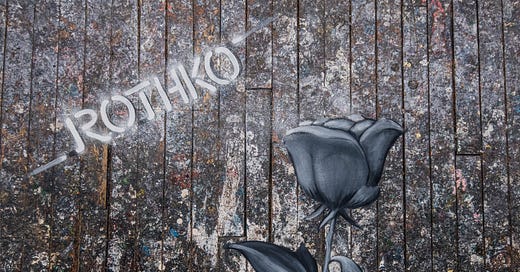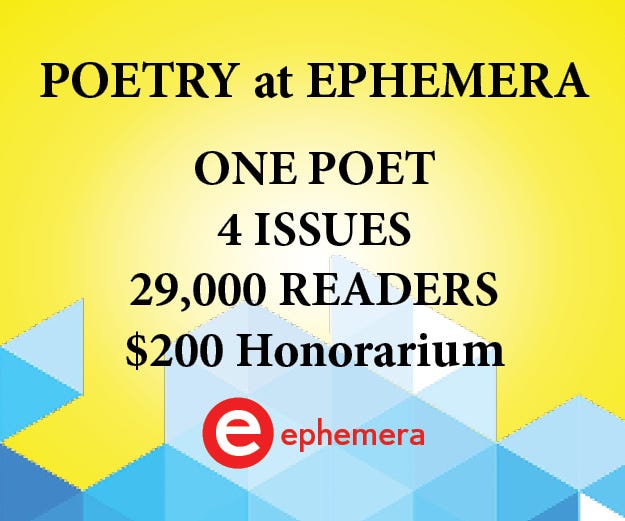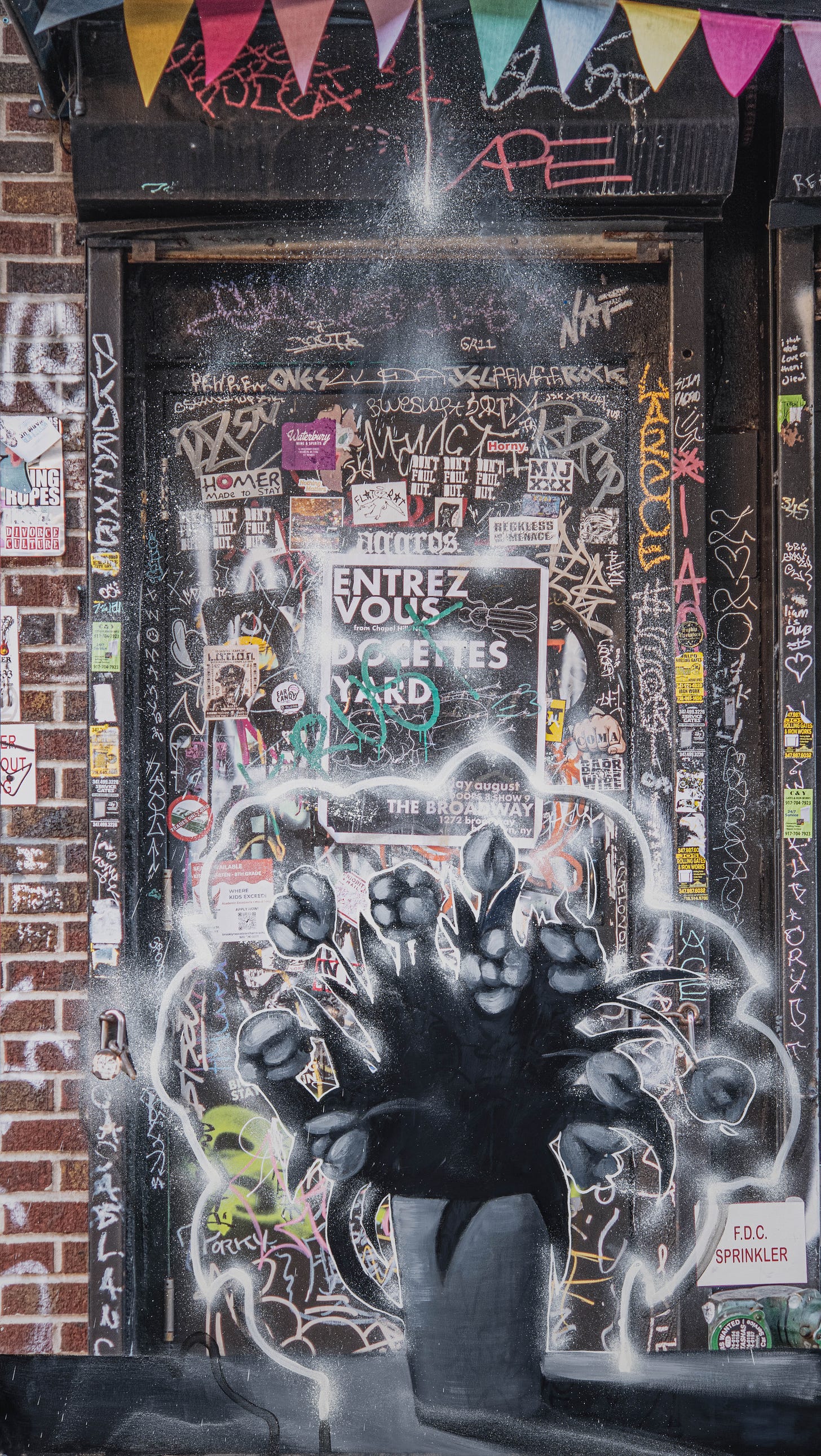Welcome to the Ephemera Newsletter free edition, Baninga! (Lingala for “friends”)
We’re celebrating Lauren Fancher, Ephemera’s poet for the month of June! You can review her poems altogether once they publish as well as her artist statement and bio on this dedicated post on our Substack page. We thank you for checking out Lauren’s work.
On to our standard content matters: Won’t you please check out last week’s issue if you haven’t yet.
And here are some reminders:
Invite to Submit: We are open for August now. June 30 is the deadline. If you are a paid subscriber to Ephemera, you can submit to poetry @ Ephemera for free as a membership perk! (We email you a secret link at the end of your second consecutive paid month and every month thereafter for as long as you are a paid subscriber). Free subscribers and anyone else can submit, too, with the reading fee and can submit up to 10 poems. Paying the reading fee will grant you 1-month paid access to Ephemera’s full letter. Learn more or:
In Brief…this week’s features:
Thoughts on Gregory de la Haba’s new collaborative work.
Listening to Long Beach Dub Allstars’ “Listen to D.J.’s.”
June’s poet, Lauren Fancher second of four poems, “I Saw.”
Our weekly lists:
3 magazines with open calls
3 awards/prizes
3 recent job listings for editors and writers.
Interesante! An article about the importance of ritual backed by multi-cultural studies.
Book Recs, bonus content, and our mini-essays to start!
Last Week’s Issue.
Merci. Danke. Kiitos. 고마워 Go-ma-wo. Cảm ơn. Xiè xiè.
Ephemera
Dear Readers,
We’re doing our summer walkabout thing. Sometimes during these seasonal transitions we get antsy and cannot sit at our desks. Focusing proves to be difficult. The Work feels less inspirational and more grinding. We sort of spent spells and spells sunken by our desks all winter, from solstice to solstice, scribbling thoughts and scavenging those scribbles for sultry ideas. But warmth! Oh, warming day star, we’re feeling social again. And so, we found ourselves, due to a wedding invitation, in the NYC area where, one post-meetings work day, stranded in Manhattan with nowhere welcoming to rest, we called upon an artist contact who invited us to his studio and home in Queens. There we vamoosed, finding Gregory de la Haba, artist and renaissance personality, hosting Finnish artist, Hannu Palosuo, at his studio where they were collaborating on new work—de la Haba finished a piece, left the studio to Palosuo, and returned anew when we arrived to view the striking additions (see below). We were particularly inspired and wowed.
Because of de la Haba and Palosuo, we’re wondering how we can collaborate in meaningful ways through our writing with other writers and maybe with artists. There’s the old standby of hosting readings, which, of course, we encourage. But what about collaborations at the generative level, with and within our art? Admittedly, collaborative work experiences difficulty in the publishing market. So we’re thinking about the inspirational components of working closely with another writer, perhaps sharing a writing space, engaging in weekly focused calls or conversations about writing, sharing and critiquing work at the generative stages in myriad ways, borrowing characters created by a peer (with permission) or even scenarios, prompts, lines, loves, images, or what have you. Maybe spending an intimate week with a writing friend in their office conducting solo sessions in proximity, reviewing work, trading lines, using your pal’s ideas as an exercise, and allowing them to write into your draft according to their whim or a predetermined set of rules. The idea here is to enable each participant to see themselves and their work differently. Differently generate. Generously gift lines and thoughts to your collaborator to use or discard or disrupt. Disruption. Disrupt yourself when you’ve reached an impasse. Or simply to experience something new. Let’s call it…collaborative disruption.
Botondi!
(Gratitude)
Poetry by Lauren Fancher
I Saw I saw a man with a clothespin for a nose A clothespin nose an orange clothespin He stood by a truck in the gas station parking lot. He was hairy and green and unshaven. He was smiling. He had an orange ear piece, not a nose. He still seemed deformed. I saw a man with a clothespin for a soul.
Music: Long Beach Dub Allstars
LBDA, as the acronym they’re known by, came into being after the passing of Sublime’s vocalist and writer (see our write up about Sublime in last week’s letter). The two remaining band members from Sublime, along with, originally, RAS-1, formed LBDA inclusive of several other musicians who have changed over time. At present, LBDA includes a new vocalist as RAS-1 has moved on to other projects. Theirs is a checkered past in terms of band members in and out, which is not unusual in the band realm and we won’t go into those politics, though folks who are intrigued by those relationships will find the history an enticing read. Included in that history are starts and stops where the band alternately went on hiatus and or reunited for tours. Past and present, LBDA plays in the ska/reggae/rock/hip-hop/dub style similar to Sublime though heavier on additional pieces and what’s known as dub, a sub-genre of reggae that emphasizes instrumental recordings over which vocals are later added with additional effects like reverb, echo, and heightened rhythm and bass. Check out the history of the term because it’s interesting and highly specific such that a quick summary doesn’t fully explain the cultural origins and specificity of the term.
We’re vibing to LBDA’s “Listen TO DJ’s,” which is now a type of reggae-dub classic having released over 20 years ago. It reminds us of summer, of course, but also to be mindful (a component of our interest that we’ll unravel a bit next). Part of what draws us to this track is the fantastic and dramatic intro, which is just a measure or two capped by a solid drum flare, an adornment that finds itself into the song in several places. We quickly dive into the primary dub-reggae instrumentation followed by a hook that stars in this song. The delivery and execution of the lyrics, mainly a list of favorite music influences for the band, contains a comforting affectation. You feel in familiar hands. There’s a tinge of admiration in the tone. It’s super positive, excited too, both of which make it summery and light in some respects. It’s a fun track with compelling, well-mixed instrumentals and effects. Long time a favorite from this group, we really love the taking stock of influences.
“You got to listen to DJ's from across the globe
Because this type of music it'll never go old
Might be on your radio every Sunday
So listen what your DJ plays”
—LBDA, Lyrics to “Listen To DJ’s”
One of the attributes of LBDA—as well as Sublime—that we enjoy and admire (aspire to) is their paying tribute to their influences, coming up and contemporary. They treat these influences as of equal import and weight, which makes a statement about the developmental process of the artist. The influences of youth are typically less sophisticated though no less important than artistic influences once anyone has “arrived” to whatever extent they have. And influences will change as one ages into their art and style and self-awareness. This taking stock, particularly in song format—we’ll often see musicians and artists call out their top influences in interviews and essays—is a tad unusual, more importantly, it’s warming in several ways, not the least of which is the indication of a humility and gratefulness. We should be grateful to our predecessors on whose backs, with whose discoveries and insights, we tend to build out our own creative practices and styles.
We love the explicit homage, the impulse to nod to their pals, heroes, and favorites; too, the ingenuity to fit all the callouts into a chill, consumable format. Maybe there’s not much crossover potential for writers in terms of calling out influences in our pieces, but there’s a gratitude present that we’d love to adapt. Too, a conscious effort to keep our influences in mind, close to heart. With this sort of practice, we’re sure to be able to produce, homage, quote, reference, and glance-to with love, compellingly and consumably. Finally, listen and read widely from across the globe, as LBDA says, including from the old days. Be interested and consume eclectically.
LBDA’s homepage.
Writers Submit: 3 Magazines
An online Mid-Atlantic journal that publishes all things literary. “...committed to the quirky, the dark, the artistic…,” the magazine publishes all genres, and aside from the magazine, has many other publishing opportunities. DEADLINE JUNE 30
A newish 2022 online magazine looking for work in all genres including criticism that is “consciousness-forward fiction and thought in the fearless, revolutionary tradition of High Modernism.” Submissions are free. DEADLINE AUGUST 5
Best known for their simple editions that feature one short story in a simple volume. The magazine has an open call this year for stories and poems with the theme of Tales from the Cleaners. Submissions are free. DEADLINE UNTIL THE ISSUE FULL
Weekly Artist: Gregory de la Haba
Interdisciplinary artist Gregory de la Haba hails from New York City where he currently keeps a home and a studio space, both of which we visited recently. The Harvard educated de la Haba also studied art at Museum School of Fine Arts in Boston, and the Universidad Sacrado Corazon in Puerto Rico. His art has been exhibited around the world at numerous galleries, biennials, exhibitions, and shows, and has found an audience with European and Asian collectors alike. We’re impressed with de la Haba’s eye, his considerable support of other artists, his patronage, and elan all of which seem to contribute to a wide range of interests and contributions to the art world that go beyond his personal practice, contributions which include incisive writing and art criticism, publishing, curating, advocacy through his Bodega de la Haba and more. His advocacy, in particular, has led to myriad collaborations with other important artists locally and from around the world, a cooperative ethos that we’re inspired by.
In NYC, we tend to drive these days. So, braving a mid day wreck, delayed 30 minutes beyond what it should have taken, we managed to pull up to his lovely walled house situated with several others on a triangular outcropping where a piece of Long Island noses into the East River by Powell Cove and the Whitestone Bridge. In the back yard, past a hand built rose garden, beside a deck flanked by high walls which serves as an outside studio space of sorts, we walked into his garage-turned studio with oodles of air space and walls covered with new work. Finished canvases stand on end in stacks here and there, while a work bench fit with wheels maneuvers easily around the room, which is scattered with the paraphernalia of a painter, all the paints and brushes and bits and bobs one could imagine. De la Haba greeted me under a table with an umbrella just outside the studio, ready to serve me a hand pressed juice. We migrated into the studio together, which was notable because the artist Hannu Palosuo was finishing up some additions to pieces GdlH had not yet seen. We’ve shared some of them with you above and below, and note these are brand new not yet shared or announced. We’ve been granted permission to share with our letter, which we’re thrilled to do!
“Bodega de la Haba was a platform I created to assist in showcasing artists, poets, and writers I found fascinatingly interesting and who weren't necessarily getting the proper shine worthy of their work. From curating shows, hosting literary events in local bars and or writing essays about their art was an enjoyable and stimulating way to meet fellow artists and to truly learn about fine art. … witnessing genuine art firsthand directly from the artist’s studios, being schooled by their mastery, is humbling and inspiring and keeps the flame within burning bright.”
―Gregory de la Haba, from lofficiel.at
Before we consider the collaborative work, we recommend looking into the last few years of GdlH’s work, particularly since Covid as he built his home studio and became quite prolific. He continues his “Portals” series with doors from around NYC which includes additional collaborations with local artists; too, his “Duende” series exploring what amounts to epiphany achieved via the artistic process—a welling up, an exhilarating state of being where the senses are heightened, access to the divine flows. Another new related series called “Light Tension,” which we can’t resist referring to as his “String Theory” series because of the stringy globules of light blown up from the ultimate microcosm and forming the ostensible shapes that lead to matter. We recommend a perusal of his website (linked below) where there are even more recent pieces to take inspiration from. From a creative’s perspective, we marvel at his productivity and inspiration. (Note to selves: when our travels are complete, hunker down and get to writing!)
Hannu had just put some final touches on the boy in the painting just above when we entered, and we were struck by the contrast in style, the shadow and gray scale figure set against an NYC “portal” or doorway marred by graffiti as in GdlH’s similar paintings, but with key editions, including the light band—with a nod to the “Light Tension” concept and the trains above which practically roared over invisible metal rails that you might see at various points in Queens, Brooklyn, and the Bronx (and briefly in spots in upper Manhattan). We were touched. The quiet boy, almost sulking, a little distraught, maybe irked by the chaos and maybe fleeing outdoors from his cramped apartment with too-loud siblings, thumping and bumping neighbors, and aggrieved parents of any sort you might imagine. But all this interiority is a quiet rage. The boy is a leaf relative to the backdrop. Maybe a ghost. A feeling all too familiar to NYC denizens current and past.
The black and white flowers in the piece below present a similar juxtaposition, but these flowers tended to alternate between quiet and loud, quiet in the ways of the boy, someone’s leftovers discarded by the curb, a lover’s rejected offering maybe, or loud because they do shine a bit, they do nearly wink in the way of the weirdos who purposely compose their look to counter the city rather than blend in. These flowers, in the alternate, enjoy their colorlessness, in fact boast about it. They glow black and white. Deliver a middle finger to the myriad tags and posters competing like single celled organisms as we imagine them in the primordial ooze. Eat or be eaten. Become adorned or be forgotten. Similarly, the flower in our headline image above reacts to its environs with an even simpler offering. One stem amidst the paints and gums and glues of the wooden backdrop, though this backdrop cryptically calls out to Rothko. We’ll let our readers wade into the meaning on this one.
After touring the space, shaking hands, a quick chat and a few chugs of juice, the artists offed to a gathering in the East Village and we hopped back into our ride and meandered back to our staging grounds in the burbs left with our thoughts to unravel. Something about these collaborative paintings touched a nerve. Contributions from two artists from vastly different cities and circumstances with different training and perspectives came together and produced work that feels tremendous. It feels as though a realization was breached, something essential about urbanity and the inner being of us beings. Being the contemplative sorts, this work has stuck with us. We’ve seen flashes of it here and there in strange situations, a good recalling of a highly visual and affecting dream in flashes.
There’s something powerful to be gained when collaboration works. It won’t be easy with the written word. Visual styles can mesh even when intention, tone, and technique do not with painting. Writing is quixotic. Our kernels of meaning ephemeral at times, difficult to keep alive with one author, let alone a second and unthinkably a third. Yet we wonder how writers might deploy collaboration. Perhaps this is an instance when we hear from readers. Perhaps writing isn’t the right medium…sure, it can be done, but our barrier to entry is so high…the time it takes so long…but then the poets, they might excel in these waters. Looking back to our intro essay, we return to the idea of collaborative conception—working together at an early stage before the page is complete. The generative phase. That might be where we can aim our colabs.
Interesante: Hidden Powers of Ritual
From: Thereader.Mitpress
— (10 min read/20 min study)
Keep reading with a 7-day free trial
Subscribe to Ephemera to keep reading this post and get 7 days of free access to the full post archives.






